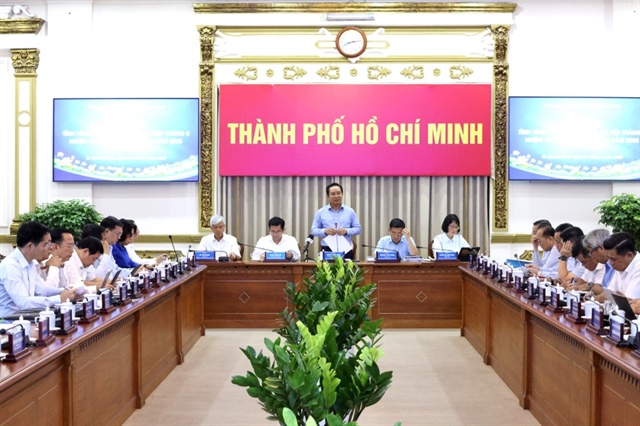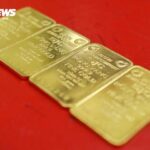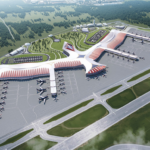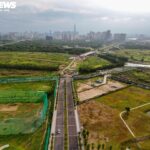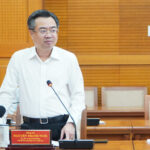On June 3, Chairman of the People’s Committee of Ho Chi Minh City, Nguyen Van Duoc, chaired a meeting on the socio-economic situation in May and the tasks and solutions for June 2025.
Opening the meeting, Chairman Nguyen Van Duoc assessed that in the first half of 2025, Ho Chi Minh City had both favorable and unfavorable conditions, but the favorable conditions were fewer compared to the challenges.
 Overview of the socio-economic meeting for the first five months of 2025. Photo: TTBC |
However, the statistical figures still showed positive signs for the city’s economy, although they fell short of expectations. The macroeconomic indicators, especially in the fields of industry, commerce, services, and tourism, continued to be the main drivers of the city’s growth.
A US$2 billion investment after a one-hour meeting
According to Chairman Nguyen Van Duoc, in the first five months of the year, the number of investment projects surpassed the same period in 2024. “Although it hasn’t met our expectations, this is encouraging news, indicating a restart and renewed confidence from domestic investors in the investment environment in Ho Chi Minh City,” he emphasized. He added that in the early months of the year, the city’s leaders had met with many investors. Notably, there was a company that decided to invest US$2 billion in a project after just an hour-long meeting.
Mr. Duoc attributed these positive changes to the gradual improvement, adaptation, and shift in the mindset and attitude of officials towards investors.
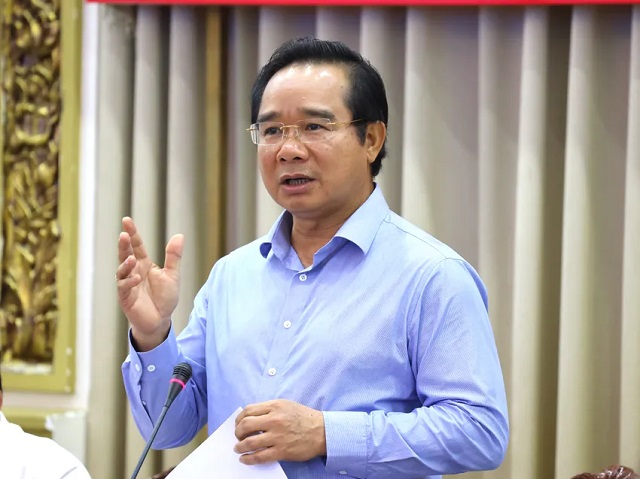
Chairman of Ho Chi Minh City People’s Committee, Nguyen Van Duoc, speaks at the meeting. Photo: TTBC
|
The construction of a multi-purpose high-tech center in Ho Chi Minh City has gained momentum, attracting many domestic and foreign investors, with more investors waiting. “With a clear direction, we will attract even more investors,” Mr. Duoc stated.
However, Chairman Nguyen Van Duoc acknowledged that some targets had not been met. He pointed out that, in the current context, achieving double-digit growth as set out was very challenging. Nonetheless, he affirmed that the city would make utmost efforts to achieve and exceed the targets assigned by the Central Government, striving for the highest possible growth rate.
Mr. Duoc also assessed that the contribution of state-owned enterprises tended to decrease recently. “The current state-owned enterprise model needs to be renewed with a more suitable one to further promote the role of the state economy,” he added.
Regarding public investment, he considered the results modest. In the first five months, the city disbursed only over 10% of the plan, lower than the country’s average of 15%.
Meanwhile, budget revenue reached over 47%, but according to the Chairman of Ho Chi Minh City, many revenue sources had not yet met their targets. He suggested assigning additional tasks to the agriculture and environment, and construction sectors, among others.
Identifying New Growth Drivers for the New Ho Chi Minh City
Mr. Nguyen Khac Hoang, Head of the Ho Chi Minh City Statistics Office, assessed that the socio-economic situation in April and May of Ho Chi Minh City had improved. Festivals and tourism activities boosted the growth of commerce, services, and industrial production.
 Mr. Nguyen Khac Hoang, Head of Ho Chi Minh City Statistics Office. Photo: TTBC |
However, he predicted that the socio-economic situation in the last six months would be challenging. In particular, the issue of retaliatory taxes from the US would continue to hinder Ho Chi Minh City’s production. Disbursement of public investment as of the end of May reached just over 10%, with no positive changes, requiring more drastic solutions.
Mr. Hoang pointed out that Ho Chi Minh City’s inflation rate was currently high. According to statistics from the Ho Chi Minh City Statistics Office, the consumer price index (CPI) in May increased by 0.35% compared to the previous month and by 4.5% over the same period.
CPI for the first five months increased by 4.27%. Of the 11 groups of goods and services, eight groups saw an increase in prices, with the highest being medicines and medical services (17%). Three groups experienced a decrease in prices, with the most significant being the transportation group (1.8%).
According to Mr. Hoang, Ho Chi Minh City’s inflation rate is higher than that of the country and neighboring provinces like Binh Duong and Ba Ria – Vung Tau (around 1.5-2%). He suggested re-evaluating the city’s consumption stimulus and market stabilization programs.
The Head of the Statistics Office suggested that when rearranging the apparatus, the city should minimize disruptions and interruptions to work. “Ho Chi Minh City needs to work closely with Binh Duong and Ba Ria – Vung Tau right now to identify new growth drivers for the new Ho Chi Minh City and have an operational plan in place as soon as the new city comes into being, to meet the growth requirements set by the Central Government, at least 8%,” Mr. Hoang emphasized.
Dr. Truong Minh Huy Vu, Director of the Ho Chi Minh City Institute for Development Research, said that psychologically, the enthusiasm for the merger would create many positive effects in the second quarter and the following months, provided that the city took concrete actions.
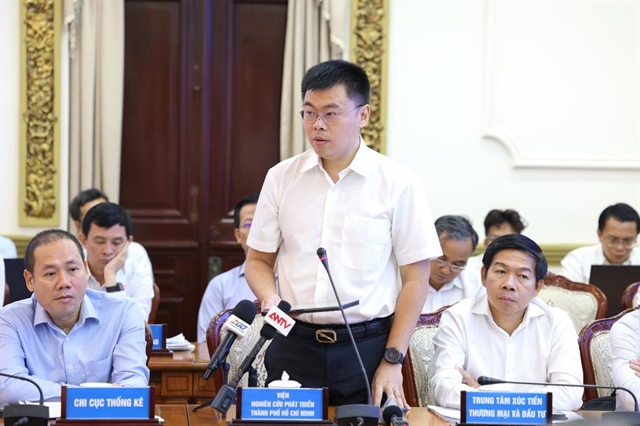 Dr. Truong Minh Huy Vu, Director of Ho Chi Minh City Institute for Development Research. Photo: TTBC |
Dr. Vu analyzed that the merger would lead to two trends. The positive trend is that the pending projects, programs, and tasks would be accelerated. The negative trend is the wait-and-see attitude until the new apparatus is stable. “The data for May clearly showed this issue,” Dr. Vu said, emphasizing that May and June are pivotal months in deciding whether the city will achieve the 8.5% growth rate in 2025. He believed that the city could achieve this growth rate if it pivots and promotes the resolution of pending issues. Otherwise, the city will face many difficulties in the last two quarters of the year.
|
Tourism revenue reached nearly VND 98,000 billion in the first five months According to the People’s Committee of Ho Chi Minh City, the socio-economic situation in May and the first five months of 2025 continued to achieve positive results, with growth rates higher than the previous month and the same period last year. Total retail sales of goods and service revenue in May were estimated at over VND 113,000 billion, up 19% over the same period; the cumulative figure for the first five months was estimated at over VND 540,000 billion, up 16.8% over the same period in 2024. Export turnover in May was estimated at US$4.37 billion, up 3.4% over the previous month; the cumulative figure for the first five months was estimated at US$20.36 billion, up 16.1% over the same period. Total tourism revenue in May was estimated at over VND 21,000 billion, up 34.1% over the same period; the cumulative figure for the first five months was estimated at nearly VND 98,000 billion, up 28.9%. The industrial production index (IIP) in May increased by 5.1% compared to the previous month and by 9.4% over the same period in 2024; the cumulative IIP for the first five months increased by 8.2% over the same period. As of May 28, according to preliminary data provided by the State Treasury Region II, the city’s disbursement was VND 8,710 billion, reaching 10.2%. Total state budget revenue in the first five months reached over VND 245,000 billion, equivalent to 47.26% of the estimate, up 4.38% over the same period. |
BAO PHUONG
– 11:25 06/03/2025
Two Offal Soup Restaurants Fined in Ho Chi Minh City
“Ho Chi Minh City authorities inspected 27 food establishments and offal/meat by-product vendors, uncovering two instances of non-compliance.”
The Power of Four: Unveiling the Task Forces of the Party Committee of Ho Chi Minh City’s Party Agencies
The Ho Chi Minh City Party Committee has established four task forces to oversee and guide the congresses of party cells and grass-roots-level party committees for the 2025-2030 term.

